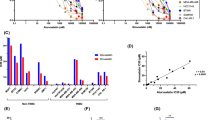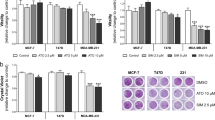Abstract
Lipophilic statins purportedly exert anti-tumoral effects on breast cancer by decreasing proliferation and increasing apoptosis. HMG-CoA reductase (HMGCR), the rate-limiting enzyme of the mevalonate pathway, is the target of statins. However, data on statin-induced effects on HMGCR activity in cancer are limited. Thus, this pre-operative study investigated statin-induced effects on tumor proliferation and HMGCR expression while analyzing HMGCR as a predictive marker for statin response in breast cancer treatment. The study was designed as a window-of-opportunity trial and included 50 patients with primary invasive breast cancer. High-dose atorvastatin (i.e., 80 mg/day) was prescribed to patients for 2 weeks before surgery. Pre- and post-statin paired tumor samples were analyzed for Ki67 and HMGCR immunohistochemical expression. Changes in the Ki67 expression and HMGCR activity following statin treatment were the primary and secondary endpoints, respectively. Up-regulation of HMGCR following atorvastatin treatment was observed in 68 % of the paired samples with evaluable HMGCR expression (P = 0.0005). The average relative decrease in Ki67 expression following atorvastatin treatment was 7.6 % (P = 0.39) in all paired samples, whereas the corresponding decrease in Ki67 expression in tumors expressing HMGCR in the pre-treatment sample was 24 % (P = 0.02). Furthermore, post-treatment Ki67 expression was inversely correlated to post-treatment HMGCR expression (rs = −0.42; P = 0.03). Findings from this study suggest that HMGCR is targeted by statins in breast cancer cells in vivo, and that statins may have an anti-proliferative effect in HMGCR-positive tumors. Future studies are needed to evaluate HMGCR as a predictive marker for the selection of breast cancer patients who may benefit from statin treatment.



Similar content being viewed by others
References
Ahern TP, Pedersen L, Tarp M, Cronin-Fenton DP, Garne JP, Silliman RA, Sorensen HT, Lash TL (2011) Statin prescriptions and breast cancer recurrence risk: a Danish nationwide prospective cohort study. J Natl Cancer Inst 103:1461–1468. doi:10.1093/jnci/djr291
Bennis F, Favre G, Le Gaillard F, Soula G (1993) Importance of mevalonate-derived products in the control of HMG-CoA reductase activity and growth of human lung adenocarcinoma cell line A549. Int J Cancer 55:640–645
Bonovas S, Filioussi K, Tsavaris N, Sitaras NM (2005) Use of statins and breast cancer: a meta-analysis of seven randomized clinical trials and nine observational studies. J Clin Oncol 23:8606–8612
Borgquist S, Djerbi S, Ponten F, Anagnostaki L, Goldman M, Gaber A, Manjer J, Landberg G, Jirstrom K (2008) HMG-CoA reductase expression in breast cancer is associated with a less aggressive phenotype and influenced by anthropometric factors. Int J Cancer 123:1146–1153
Borgquist S, Jogi A, Ponten F, Ryden L, Brennan DJ, Jirstrom K (2008) Prognostic impact of tumour-specific HMG-CoA reductase expression in primary breast cancer. Breast Cancer Res 10:R79. doi:bcr214610.1186/bcr2146
Boudreau DM, Yu O, Miglioretti DL, Buist DS, Heckbert SR, Daling JR (2007) Statin use and breast cancer risk in a large population-based setting. Cancer Epidemiol Biomarkers Prev 16:416–421
Brennan DJ, Laursen H, O’Connor DP, Borgquist S, Uhlen M, Gallagher WM, Ponten F, Millikan RC, Ryden L, Jirstrom K (2011) Tumor-specific HMG-CoA reductase expression in primary premenopausal breast cancer predicts response to tamoxifen. Breast Cancer Res 13:R12. doi:bcr282010.1186/bcr2820
Campbell MJ, Esserman LJ, Zhou Y, Shoemaker M, Lobo M, Borman E, Baehner F, Kumar AS, Adduci K, Marx C, Petricoin EF, Liotta LA, Winters M, Benz S, Benz CC (2006) Breast cancer growth prevention by statins. Cancer Res 66:8707–8714
Cauley JA, McTiernan A, Rodabough RJ, LaCroix A, Bauer DC, Margolis KL, Paskett ED, Vitolins MZ, Furberg CD, Chlebowski RT (2006) Statin use and breast cancer: prospective results from the Women’s Health Initiative. J Natl Cancer Inst 98:700–707. doi:10.1093/jnci/djj188
Chan KK, Oza AM, Siu LL (2003) The statins as anticancer agents. Clin Cancer Res 9:10–19
Clendening JW, Pandyra A, Boutros PC, El Ghamrasni S, Khosravi F, Trentin GA, Martirosyan A, Hakem A, Hakem R, Jurisica I, Penn LZ (2010) Dysregulation of the mevalonate pathway promotes transformation. Proc Natl Acad Sci USA 107:15051–15056. doi:091025810710.1073/pnas.0910258107
Clendening JW, Penn LZ (2012) Targeting tumor cell metabolism with statins. Oncogene. doi:10.1038/onc.2012.6
Dale KM, Coleman CI, Henyan NN, Kluger J, White CM (2006) Statins and cancer risk: a meta-analysis. JAMA 295:74–80
Demierre MF, Higgins PD, Gruber SB, Hawk E, Lippman SM (2005) Statins and cancer prevention. Nat Rev Cancer 5:930–942. doi:10.1038/nrc1751
Dowsett M, Nielsen TO, A’Hern R, Bartlett J, Coombes RC, Cuzick J, Ellis M, Henry NL, Hugh JC, Lively T, McShane L, Paik S, Penault-Llorca F, Prudkin L, Regan M, Salter J, Sotiriou C, Smith IE, Viale G, Zujewski JA, Hayes DF (2011) Assessment of Ki67 in breast cancer: recommendations from the International Ki67 in Breast Cancer working group. J Natl Cancer Inst 103:1656–1664. doi:10.1093/jnci/djr393
Dowsett M, Smith IE, Ebbs SR, Dixon JM, Skene A, A’Hern R, Salter J, Detre S, Hills M, Walsh G (2007) Prognostic value of Ki67 expression after short-term presurgical endocrine therapy for primary breast cancer. J Natl Cancer Inst 99:167–170
Dowsett M, Smith IE, Ebbs SR, Dixon JM, Skene A, Griffith C, Boeddinghaus I, Salter J, Detre S, Hills M, Ashley S, Francis S, Walsh G (2005) Short-term changes in Ki-67 during neoadjuvant treatment of primary breast cancer with anastrozole or tamoxifen alone or combined correlate with recurrence-free survival. Clin Cancer Res 11:951s–958s
Duncan RE, El-Sohemy A, Archer MC (2005) Regulation of HMG-CoA reductase in MCF-7 cells by genistein, EPA, and DHA, alone and in combination with mevastatin. Cancer Lett 224:221–228
Emberson JR, Kearney PM, Blackwell L, Newman C, Reith C, Bhala N, Holland L, Peto R, Keech A, Collins R, Simes J, Baigent C (2012) Lack of effect of lowering LDL cholesterol on cancer: meta-analysis of individual data from 175,000 people in 27 randomised trials of statin therapy. PLoS One 7:e29849. doi:10.1371/journal.pone.0029849
Endo A (1992) The discovery and development of HMG-CoA reductase inhibitors. J Lipid Res 33:1569–1582
Endo A, Kuroda M, Tanzawa K (1976) Competitive inhibition of 3-hydroxy-3-methylglutaryl coenzyme A reductase by ML-236A and ML-236B fungal metabolites, having hypocholesterolemic activity. FEBS Lett 72:323–326
Garwood ER, Kumar AS, Baehner FL, Moore DH, Au A, Hylton N, Flowers CI, Garber J, Lesnikoski BA, Hwang ES, Olopade O, Port ER, Campbell M, Esserman LJ (2010) Fluvastatin reduces proliferation and increases apoptosis in women with high grade breast cancer. Breast Cancer Res Treat 119:137–144. doi:10.1007/s10549-009-0507-x
Goldstein JL, Brown MS (1990) Regulation of the mevalonate pathway. Nature 343:425–430
Graaf MR, Beiderbeck AB, Egberts AC, Richel DJ, Guchelaar HJ (2004) The risk of cancer in users of statins. J Clin Oncol 22:2388–2394
Gruenbacher G, Gander H, Nussbaumer O, Nussbaumer W, Rahm A, Thurnher M (2010) IL-2 costimulation enables statin-mediated activation of human NK cells, preferentially through a mechanism involving CD56 + dendritic cells. Cancer Res 70:9611–9620. doi:10.1158/0008-5472.CAN-10-1968
Grundy SM (1988) HMG-CoA reductase inhibitors for treatment of hypercholesterolemia. N Engl J Med 319:24–33. doi:10.1056/NEJM198807073190105
Higgins MJ, Prowell TM, Blackford AL, Byrne C, Khouri NF, Slater SA, Jeter SC, Armstrong DK, Davidson NE, Emens LA, Fetting JH, Powers PP, Wolff AC, Green H, Thibert JN, Rae JM, Folkerd E, Dowsett M, Blumenthal RS, Garber JE, Stearns V (2012) A short-term biomarker modulation study of simvastatin in women at increased risk of a new breast cancer. Breast Cancer Res Treat 131:915–924. doi:10.1007/s10549-011-1858-7
Joo JH, Jetten AM (2010) Molecular mechanisms involved in farnesol-induced apoptosis. Cancer Lett 287:123–135. doi:10.1016/j.canlet.2009.05.015
Kaneko I, Hazama-Shimada Y, Endo A (1978) Inhibitory effects on lipid metabolism in cultured cells of ML-236B, a potent inhibitor of 3-hydroxy-3-methylglutaryl-coenzyme-A reductase. Eur J Biochem 87:313–321
Keyomarsi K, Sandoval L, Band V, Pardee AB (1991) Synchronization of tumor and normal cells from G1 to multiple cell cycles by lovastatin. Cancer Res 51:3602–3609
Kumar AS, Benz CC, Shim V, Minami CA, Moore DH, Esserman LJ (2008) Estrogen receptor-negative breast cancer is less likely to arise among lipophilic statin users. Cancer Epidemiol Biomarkers Prev 17:1028–1033
Laufs U, Gertz K, Huang P, Nickenig G, Bohm M, Dirnagl U, Endres M (2000) Atorvastatin upregulates type III nitric oxide synthase in thrombocytes, decreases platelet activation, and protects from cerebral ischemia in normocholesterolemic mice. Stroke 31:2442–2449
Lee SJ, Ha MJ, Lee J, Nguyen P, Choi YH, Pirnia F, Kang WK, Wang XF, Kim SJ, Trepel JB (1998) Inhibition of the 3-hydroxy-3-methylglutaryl-coenzyme A reductase pathway induces p53-independent transcriptional regulation of p21(WAF1/CIP1) in human prostate carcinoma cells. J Biol Chem 273:10618–10623
Lennernas H (2003) Clinical pharmacokinetics of atorvastatin. Clin Pharmacokinet 42:1141–1160
Liao JK (2002) Isoprenoids as mediators of the biological effects of statins. J Clin Invest 110:285–288
McShane LM, Altman DG, Sauerbrei W, Taube SE, Gion M, Clark GM (2006) REporting recommendations for tumor MARKer prognostic studies (REMARK). Breast Cancer Res Treat 100:229–235. doi:10.1007/s10549-006-9242-8
Mo H, Elson CE (2004) Studies of the isoprenoid-mediated inhibition of mevalonate synthesis applied to cancer chemotherapy and chemoprevention. Exp Biol Med (Maywood) 229:567–585
Nielsen SF, Nordestgaard BG, Bojesen SE (2012) Statin use and reduced cancer-related mortality. N Engl J Med 367:1792–1802. doi:10.1056/NEJMoa1201735
Niraula S, Dowling RJ, Ennis M, Chang MC, Done SJ, Hood N, Escallon J, Leong WL, McCready DR, Reedijk M, Stambolic V, Goodwin PJ (2012) Metformin in early breast cancer: a prospective window of opportunity neoadjuvant study. Breast Cancer Res Treat. doi:10.1007/s10549-012-2223-1
Romero Q, Bendahl PO, Klintman M, Loman N, Ingvar C, Ryden L, Rose C, Grabau D, Borgquist S (2011) Ki67 proliferation in core biopsies versus surgical samples - a model for neo-adjuvant breast cancer studies. BMC Cancer 11:341. doi:1471-2407-11-34110.1186/1471-2407-11-341
Sacks FM, Pfeffer MA, Moye LA, Rouleau JL, Rutherford JD, Cole TG, Brown L, Warnica JW, Arnold JM, Wun CC, Davis BR, Braunwald E (1996) The effect of pravastatin on coronary events after myocardial infarction in patients with average cholesterol levels. Cholesterol and recurrent events trial investigators. N Engl J Med 335:1001–1009. doi:10.1056/NEJM199610033351401
Shepherd J, Cobbe SM, Ford I, Isles CG, Lorimer AR, MacFarlane PW, McKillop JH, Packard CJ (1995) Prevention of coronary heart disease with pravastatin in men with hypercholesterolemia. West of Scotland Coronary Prevention Study Group. N Engl J Med 333:1301–1307. doi:10.1056/NEJM199511163332001
Spyratos F, Ferrero-Pous M, Trassard M, Hacene K, Phillips E, Tubiana-Hulin M, Le Doussal V (2002) Correlation between MIB-1 and other proliferation markers: clinical implications of the MIB-1 cutoff value. Cancer 94:2151–2159. doi:10.1002/cncr.10458
Thurnher M, Nussbaumer O, Gruenbacher G (2012) Novel aspects of mevalonate pathway inhibitors as antitumor agents. Clin Cancer Res 18:3524–3531. doi:10.1158/1078-0432.CCR-12-0489
Undela K, Srikanth V, Bansal D (2012) Statin use and risk of breast cancer: a meta-analysis of observational studies. Breast Cancer Res Treat 135:261–269. doi:10.1007/s10549-012-2154-x
Wejde J, Blegen H, Larsson O (1992) Requirement for mevalonate in the control of proliferation of human breast cancer cells. Anticancer Res 12:317–324
Yachnin S, Mannickarottu V (1984) Increased 3-hydroxy-3-methylglutaryl coenzyme A reductase activity and cholesterol biosynthesis in freshly isolated hairy cell leukemia cells. Blood 63:690–693
Acknowledgments
We wish to express our profound gratitude to the study-responsive research nurse, Mrs. Charlotte Fogelström, for her devoted and trustworthy efforts. Furthermore, we wish to thank all of the dedicated nurses and doctors in the Department of Surgery and the Department of Clinical Pathology who were instrumental during the study enrollment. Our thanks also go to Mrs. Kristina Lövgren and Mr. Björn Nodin for their excellent technical assistance.
Conflict of interest
K. Jirström and M. Uhlén hold pending intellectual property in relation to HMGCR as a predictive biomarker in the treatment of breast cancer. The other authors disclosed no potential conflicts of interest.
Author information
Authors and Affiliations
Corresponding author
Rights and permissions
About this article
Cite this article
Bjarnadottir, O., Romero, Q., Bendahl, PO. et al. Targeting HMG-CoA reductase with statins in a window-of-opportunity breast cancer trial. Breast Cancer Res Treat 138, 499–508 (2013). https://doi.org/10.1007/s10549-013-2473-6
Received:
Accepted:
Published:
Issue Date:
DOI: https://doi.org/10.1007/s10549-013-2473-6




